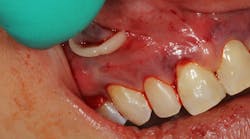Why patients don’t seek periodontists, and how to fix that
The awareness gap in periodontics
At least 10% of the population worldwide suffers from a severe form of periodontal disease, making it the sixth most prevalent condition worldwide.1 Yet public awareness around periodontics as a specialized field remains low. People may recognize the role of orthodontists and oral surgeons, but very few understand periodontists, what they do, or when they might need one. The lack of awareness around the fact that periodontists don’t just perform dental implant procedures (they also diagnose and treat advanced periodontal diseases as well as manage complex oral health conditions) directly affects treatment outcomes. To frame periodontal disease as a public health problem, awareness of the impact on health associated with periodontal disease must be clearly articulated.2
Many individuals delay treatment until their condition has worsened because they do not recognize the signs of periodontal disease. Periodontal disease can lead to tooth instability and eventually loss if it's left untreated, making it the primary cause of tooth loss among adults. Lack of knowledge or time has been reported as examples of individual obstacles by patients to neglect, avoid, or delay periodontal treatment.
Research shows that aggressive periodontal disease advances swiftly and can lead to substantial damage if not addressed promptly. It is characterized by rapid gum attachment loss and bone destruction.3 High blood pressure, drug use, smoking, and diabetes are all among the number of significant systemic conditions associated with periodontitis, including a higher number of missing teeth. Anemia, glaucoma, sinusitis, hepatitis, lymphoma, dialysis, bronchitis, and asthma are other significant conditions.4 If more people knew about it, they would take action sooner rather than later.
Lack of knowledge is why many patients end up seeing a general dentist even when they require a more specialized treatment. General dentists provide essential preventive and restorative care, but they may not have the resources or advanced training to manage severe conditions such as periodontitis, gum recession, or implant complications. Research has shown that traditional oral hygiene activities for mass chairside behavior modification depend largely on patient compliance while imparting only short-term success.5,6 As a result, patients often end up receiving short-term treatments that do not address underlying disease, leading to continued deterioration, tooth loss, and the need for complex surgical procedures. Thorough treatment planning is key to long-term functional and esthetic success and stability.
Periodontists can adopt a direct patient approach to address this issue instead of relying solely on referrals and word of mouth. By positioning themselves as specialists in advanced oral health care, they can help patients understand the importance of seeking treatment before their condition worsens.
Awareness alone does not translate to more patients
Unless a patient recognizes the need for specialist care, awareness alone will not be enough to get more patients to seek treatment. Even when some individuals have symptoms such as bleeding gums, persistent bad breath, gum recession, and loose teeth, they still do not realize it is periodontal disease that needs to be treated. This disconnect between perceived urgency and disease presence is a major reason for delayed diagnosis and treatment.
Patient engagement cannot be improved just by educating the public about periodontists; instead, periodontists must position their authority in a way that directly addresses patient concerns.
Here are some ways to do that:
- Instead of saying, “I specialize in treating periodontitis,” say, “If your gums bleed when you brush or your teeth feel loose, I can help prevent tooth loss.”
- Rather than stating, “We provide implant services,” say, “If you have missing teeth and want a permanent solution, let’s discuss how implants can restore your smile.”
By shifting the focus from general awareness to problem-solving, periodontists can reach patients who are actively seeking answers and are more likely to follow through with treatment.
Who seeks out a periodontist? A closer look at patient profiles
Typically, there are four categories of patients who are more likely to seek periodontists. Periodontists can tailor their outreach efforts by understanding each of these categories to address their specific concerns.
The frustrated patient
These individuals often receive short-term fixes from general dentists and have undergone multiple unsuccessful treatments. They may have experienced:
- Fillings or crowns placed on unstable teeth that later require extraction
- Repeated deep cleaning that failed to stop gum recession or infection
- Failed dental implants due to undiagnosed periodontal disease
When patients experience chronic discomfort, difficulty chewing, or concerns about their experience and have a history of failed dental treatments, they are more likely to seek specialist care. Patients seek help when symptoms become unmanageable.7
The bleeding gums patient
These patients have undergone multiple deep cleanings, antimicrobial therapies, and similar nonsurgical periodontal treatments but continue to experience symptoms of gum disease. They may have been advised to use special mouth rinses, floss more frequently, or take antibiotics but with little to no improvement. This is why at some point they start searching for their condition independently by asking questions such as:
- Why do my gums keep bleeding?
- What happens if gum disease is untreated?
- Do I need to see a gum specialist?
Strategies affecting prevention, control, and treatment of periodontal disease have evolved over time and are based on the concept that secondary prevention falls under the domain of oral health professionals, whereas primary intervention is the individual’s responsibility.2 Patients with persistent periodontal symptoms often seek online information before consulting a specialist. Periodontists can position themselves as the trusted authority to individuals seeking these answers online by providing educational content such as videos, articles, and patient testimonials.
The major needs patient
These are the patients who evaluate their options after receiving complex and expensive treatment plans from a general dentist. They may be considering:
- Full-arch dental implants
- Extensive gum grafting
- Comprehensive periodontal surgery
Patients investing in full-mouth rehabilitations are more likely to seek specialist care to ensure better outcomes. Research shows that many patients cannot afford to undergo the treatment even though it would reduce their risk of complications. However, sequential phasing gives the clinician an opportunity to offer necessary care without unnecessary compromises, all while maintaining the patient’s specific goals for treatment.8
The patient seeking the best possible care
Certain patients prioritize specialized expertise over convenience or cost. They may have a background in health care, a strong understanding of dentistry, or simply a high standard for medical care.
These individuals actively seek specialists by searching:
- Best implant dentist near me
- Top gum disease specialist
- Who to see for failing dental implants
By emphasizing advanced training, experience, and success rates, periodontists can appeal to this high-value patient group.
Strategies to attract patients who are ready for treatment
Creating a sense of urgency
Many periodontists focus on patient education, but education alone does not create urgency. Instead of merely explaining what periodontal disease is, periodontists should emphasize:
- The risks of delaying treatment, including tooth loss, systemic inflammation,4 and increased health-care costs
- The financial impact of untreated disease, demonstrating how earlier intervention reduces long-term expenses.
- Real patient experiences, showcasing individuals who wished they had pursued treatment sooner.
Patients who perceive greater urgency regarding their condition are more likely to proceed with treatment.
Prequalifying patients before consultation
A frequent challenge among periodontists is spending time on consultations that do not result in treatment acceptance. Case acceptance rates may improve when patients are prequalified before their appointment. Effective prequalification methods include:
- Providing transparent cost estimates up front, allowing financially unprepared patients to self-select out while serious patients can explore financing options
- Asking screening questions before booking appointments, ensuring patients are genuinely interested in receiving specialist care
- Providing preconsultation educational materials. A patient who has watched a video explaining their condition and treatment options is more likely to follow through.
Building a practice that attracts the right patients
Periodontists can take a proactive approach to patient education to:
- Reduce wasted time on low-conversion consultations
- Attract only patients who are ready to commit to treatment
- Build a patient-driven, referral-independent practice
Instead of waiting for patients to realize they need specialized care, leading periodontists create a brand that makes it clear who they help, how they do it, and why they are the right choice.
Key takeaways
- This study highlights the lack of public awareness about periodontists, leading to delayed treatment and reliance on general dentists.
- Patient education alone is insufficient; individuals must recognize their symptoms as indicators for specialized periodontal care.
- Four key patient groups are most likely to seek periodontists, including those with failed treatments, persistent symptoms, and complex needs.
- Emphasizing the risks of delaying treatment, such as tooth loss and systemic health issues, increases case acceptance.
- Prequalifying patients through transparent cost discussions and screening questions improves treatment commitment and efficiency.
- Establishing a strong brand presence that clearly communicates expertise helps attract high-quality, referral-independent patients.
Editor’s note: This article originally appeared in Perio-Implant Advisory, a chairside resource for dentists and hygienists that focuses on periodontal- and implant-related issues. Read more articles and subscribe to the newsletter.
References
- NCD Countdown 2030 Collaborators. NCD Countdown 2030: worldwide trends in non-communicable disease mortality and progress towards Sustainable Development Goal target 3.4. Lancet. 2018;392(10152):1072-1088. doi:10.1016/S0140-6736(18)31992-5
- Janakiram C, Dye BA. A public health approach for prevention of periodontal disease. Periodontol 2000. 2020;84(1):202–214. doi:10.1111/prd.12337
- Roshna T, Nandakumar K, Panaccione R. Generalized aggressive periodontitis and its treatment options: case reports and review of the literature. Case Rep Med. 2012;2012:535321. doi:10.1155/2012/535321
- Chatzopoulos GS, Jiang Z, Marka N, Wolff LF. Periodontal disease, tooth loss, and systemic conditions: an exploratory study. Int Dent J. 2023;73(6):485-493. doi:10.1016/j.identj.2023.08.002
- Zusman SP, Eaton KA, Harris M, Amariei C. A pilot project to improve the oral health of orphans and the elderly in residential care in Constanta, Romania. Community Dent Health. 2015;32(2):89-92.
- Gholami M, Pakdaman A, Montazeri A, Jafari A, Virtanen JI. Assessment of periodontal knowledge following a mass media oral health promotion campaign: a population-based study. BMC Oral Health. 2014;14:31. doi:10.1186/1472-6831-14-31
- Vennik J, Eyles C, Thomas M, et al. Chronic rhinosinusitis: a qualitative study of patient views and experiences of current management in primary and secondary care. BMJ Open. 2019;9(4):e022644. doi:10.1136/bmjopen-2018-022644
- Kois DE, Kois JC. Comprehensive risk-based diagnostically driven treatment planning: developing sequentially generated treatment. Dent Clin North Am. 2015;59(3):593-608. doi:10.1016/j.cden.2015.03.001
About the Author

Javeria Rameez Naqvi
Javeria Rameez Naqvi is an internet marketing expert, author, and entrepreneur who helps dental practice owners attract more high-value implant cases. With extensive experience in digital marketing, she specializes in strategies that bring in prequalified, ready-to-pay patients—without the struggle of chasing leads or price shoppers. Contact Javeria at [email protected].



